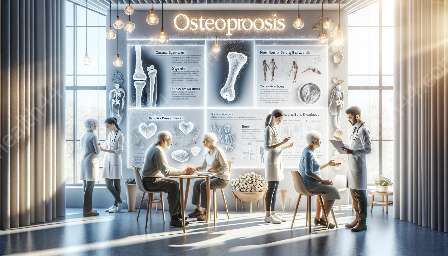Osteoporosis is a condition characterized by low bone density and increased risk of fractures, particularly in elderly individuals. As bones become more fragile and porous, the risk of fractures and complications such as immobility, hospitalization, and even mortality increases. This topic cluster will explore the impact of osteoporosis on the elderly population's health, preventative measures, and treatment options, providing valuable insights for managing bone health in older individuals.
The Significance of Osteoporosis in Elderly Individuals
Osteoporosis is a serious health concern for the elderly, especially aging women who are more susceptible to the condition. Due to decreased bone mass and altered bone microarchitecture, the risk of fractures in response to minimal trauma is significantly higher in individuals with osteoporosis. Fractures, especially those of the hip and spine, can have long-term consequences, leading to decreased mobility, chronic pain, and overall reduced quality of life. These outcomes highlight the importance of understanding and addressing osteoporosis in the elderly population.
Impact on Health and Well-being
The impact of osteoporosis on the health and well-being of elderly individuals extends beyond the immediate physical effects of fractures. Fractures can result in prolonged hospital stays, loss of independence, and reduced overall functionality. The associated pain and complications can lead to social isolation and mental health challenges, contributing to a decline in the individual's overall well-being. Understanding the holistic impact of osteoporosis on health is crucial for effective management and care.
Preventative Measures for Osteoporosis in Elderly Individuals
Prevention plays a significant role in managing osteoporosis in the elderly. Encouraging physical activity, particularly weight-bearing exercises, can help maintain bone strength. Adequate intake of calcium and vitamin D through diet and supplements is also vital for supporting bone health. Additionally, minimizing risk factors such as smoking and excessive alcohol consumption can contribute to reducing the likelihood of developing osteoporosis in later years.
Early Screening and Diagnosis
Early screening and diagnosis are crucial for identifying osteoporosis in its early stages, allowing for timely intervention and management. Bone density tests, such as dual-energy X-ray absorptiometry (DXA) scans, can help assess bone strength and diagnose osteoporosis. By identifying the condition early, healthcare providers can implement appropriate strategies to prevent further bone loss and reduce the risk of fractures in elderly individuals.
Medical Interventions and Treatment Options
For those already diagnosed with osteoporosis, various medical interventions and treatment options are available to manage the condition and minimize the risk of fractures. Pharmacological interventions, including bisphosphonates and other osteoporosis medications, can help improve bone density and reduce the likelihood of fractures. Additionally, lifestyle modifications and fall prevention strategies can further support elderly individuals in managing osteoporosis and maintaining their overall health and well-being.
Supporting Bone Health in the Elderly Population
Supporting bone health in the elderly population involves a multidimensional approach that encompasses education, lifestyle modifications, and access to appropriate healthcare resources. By promoting awareness of osteoporosis and its impact on health, as well as implementing preventative measures and timely interventions, it is possible to improve the quality of life for elderly individuals at risk of osteoporosis-related complications.
Empowering Individuals and Caregivers
Empowering elderly individuals and their caregivers with knowledge about osteoporosis and bone health is essential for fostering proactive management and reducing the burden of the condition. Education about dietary choices, exercise regimens, and safety measures to prevent falls can empower individuals to take an active role in maintaining their bone health. Caregivers, including healthcare professionals and family members, play a pivotal role in providing support and guidance to individuals affected by osteoporosis.
Conclusion
Osteoporosis in elderly individuals presents significant challenges to overall health and well-being, but with the right approach, it is possible to mitigate the impact of this condition. By focusing on prevention, early detection, and comprehensive care, the healthcare community can work towards improving the lives of elderly individuals at risk of osteoporosis-related complications. This comprehensive understanding of osteoporosis and its implications for older individuals can guide strategies for supporting bone health and ensuring a better quality of life for the elderly population.


